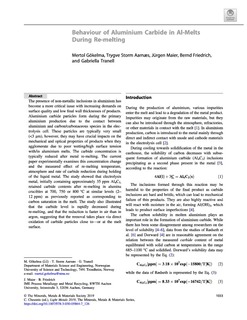Behaviour of Aluminium Carbide in Al-melts during Re-melting
Journal article, Peer reviewed
Accepted version

Åpne
Permanent lenke
http://hdl.handle.net/11250/2637535Utgivelsesdato
2019Metadata
Vis full innførselSamlinger
- Institutt for materialteknologi [2549]
- Publikasjoner fra CRIStin - NTNU [38127]
Sammendrag
The presence of non-metallic inclusions in aluminium has become a more critical issue with increasing demands on surface quality and low final wall thicknesses of products. Aluminium carbide particles form during the primary aluminium production due to the contact between aluminium and carbon/carbonaceous species in the electrolysis cell. These particles are typically very small (<3 μm), however, they may have crucial impacts on the mechanical and optical properties of products when they agglomerate due to poor wetting/high surface tension with/in aluminium melts. The carbide concentration is typically reduced after metal re-melting. The current paper experimentally examines this concentration change and the measured effect of re-melting temperature, atmosphere and rate of carbide reduction during holding of the liquid metal. The study showed that electrolysis metal, initially containing approximately 35 ppm Al4C3, retained carbide contents after re-melting in alumina crucibles at 700, 750 or 800 °C at similar levels (2–12 ppm) as previously reported as corresponding to carbon saturation in the melt. The study also illustrated that the carbide level is rapidly decreased during re-melting, and that the reduction is faster in air than in argon, suggesting that the removal takes place via direct oxidation of carbide particles close to—or at the melt surface.